Kitchen Project #89: Apple Pie
With Chloe-Rose Crabtree!
Hello,
Welcome to today’s edition of Kitchen Projects. Thank you so much for being here.
Today’s newsletter is an instalment of the KP Teacher Series where I hang out with an expert the day - and today, it’s all about Thanksgiving and pies with Chloe-Rose Crabtree, pastry chef, historian, writer.
Over on KP+, the festivities continue. I’m sharing Chloe and I’s investigation into a vintage sweet potato pie recipe, plus I have a dreamy guest recipe: Shaved brussel sprout salad with bacon and a reduced apple dressing by the ultra-talented Ben Lippett. Click here to read it.
Kitchen Projects is 100% reader funded; By joining KP+, you will support the writing and research that goes into the newsletter and get access to baking Q&As with me, extra content, community chat threads, and more. Subscribing is easy and only costs £5 per month:
Love,
Nicola
Apple (pie) of my eye
Whether you celebrate it or not, Thanksgiving is here and the internet is awash with pies, which can only be a good thing. Ever my stint in New York and being in a long-term relationship with a Midwesterner, I always do something to mark the occasion.
I love reading all the recipes and thinking of them as British Christmas prototypes - whilst the US may serve mashed potato in place of roasties, there are plenty of commonalities: Turkey, cranberry sauce, stuffing, lots of greens. One of the major areas of deviation (besides the always baffling combination of sweet potatoes and marshmallows) is the dessert: Thanksgiving is all about pies. And not the kind with fruit mince in.
Although I've covered various pies in the past, this week I had the pleasure of getting a one-on-one masterclass with Chloe-Rose Crabtree. Chloe is an LA native but a London resident - we met just before the pandemic in early March 2020 when she was managing Mei Mei in Borough Market. Before living in London, Chloe worked in various restaurants and cafes in LA and would take the lead on Thanksgiving Pie production - so, naturally, I was very excited to bake with her.
Now, Chloe is the pastry chef at London’s Bake Street (if you haven't been there yet, add it to your list!) and has worked in food and restaurants for the past decade. As well as making hundreds of tortillas every week and an ever-rotating selection of baked goods (her Guava Pastelitos are my absolute favourite but her Creme Brulee cookies regularly break the internet), Chloe is a writer, editor and researcher. She is the co-founder of Sourced, an ingredient-led research project that explores the cultural, political and commercial impact of food and drink.
Previous 'seasons' of Sourced have covered topics like 'rot', and the current season is all about rice - click here to check out the newsletter, co-authored by Anna Sulan and subscribe (your brain will thank you). And if you’re in London, check out their rice event at e5 Bakehouse on 28 November!
As Chloe showed me how to make the appliest apple pie ever (it is truly incredible), we talked about her journey to becoming a chef, the lowdown on Thanksgiving traditions, and how it is celebrated in her family.
A personal history of Thanksgiving
Growing up in the US, Chloe knows pie. When it came to Thanksgiving, it was her Grandma that took the reigns, always blending the traditional meal with alternative elements to keep things exciting. "Every year [my Grandma] complains about making the same meal - it gets so boring to cook! But no one wants to change it because they're looking forward to all the dishes. So, she always made something that was off-piste."
As Chloe got older, pies became her responsibility. And like many chefs I know, the obsession with perfection is evident. "Pie became one of these things where I was like, I'm gonna master it!" she explains. "And after years and years of making pie crust, I was able to do it in my sleep."
It's impossible to talk about Thanksgiving without considering the specific traditions that exist in each unique family unit in the US. Regional trends within America exist, but it subdivides even further depending on the family. "My family's heritage is very mixed - Chinese, Mexican, but with various white influences," explains Chloe. Her family "used to tell people that they were Hawaiian because that was still American and 'acceptable'".
As a result, the Mexican culture in her family was put to one side in an effort to stay safe in an ever-treacherous America. Even their language was hidden - Chloe's is the first generation to start speaking Spanish again. But there were defiant and preserved moments at home. "My family still kept the food - we would make Mexican food, even though we had to mask a lot of our identity."
Discovering food throughout history
This connection and discovery of her family's history through food sparked an interest in Chloe, and a persistent love for vintage cookbooks was born. After college, she studied for her master's degree in Paris, looking at cookbooks as a form of feminist literature as well as the cookbook's role in building food culture in the US. "From 1860 onwards, there's this project to unify the American identity. So that's where you have things like the American dream come about. You have these narratives about what it means to be an American. And one of the things is like eating like an American." This means that "cookbooks were a way to teach people of colour how to assimilate to American culture, and it became a way to say, 'these people are eating wrong'."
As a result, processed food became the forefront of the American diet, with pre-mixed canned food, or cake box mixes, becoming ubiquitous across the country. "Part of it was about ease," Chloe tells me, "but mostly it's about standardising the experience so that everyone has this homogenous experience of like what it is to be an American."
On KP+ today…
Over on KP+, the pie joy continues! Chloe brought one of those aforementioned vintage cookbooks to my house - a marketing pamphlet by the Pacific Intermountain Express (whose acronym is PIE), a now-defunct US trucking company. We had a go at making one of the pies for KP+ - an ultra delicious sweet potato pie.
Since Thanksgiving is also about the sides (“Leftovers are essential” Chloe tells me), I’ve asked the brilliant Ben Lippet, chef and co-owner of Dr Sting’s Hot Honey (as well as a recipe developer for Mob) to share a recipe for an ultimate green side: Shaved Sprout salad with brown butter apple dressing. I can’t even deal with how delicious this is!
So, what actually IS Thanksgiving?!
Thanksgiving is a peculiar holiday in many ways. We can all agree that the historical foundation it was built on - the manufactured story of the pilgrims and the native Americans - is bleak and not worthy of celebration. Chloe explains that the traditional Thanksgiving meal was "part of the same nation-building project of uniting people in this idea that we come from these pilgrims and we came together, and we're a melting pot and blah, blah, blah." This is reflected in the specific dishes served at the traditional Thanksgiving dinner, "like sweet potato and corn. All these things are being used that you wouldn't necessarily be seen being used in Europe."
Chloe, like a lot of Americans I know, had "cooled off" about Thanksgiving for a while thanks to the murky origins but has since found a way to enjoy it simply as a way of getting people together. "It's nice to do with friends, and it’s the only thing other than Christmas where you get together and cook, so that part, I really like." And there's pie.
Before we go any further, I’d love to know what YOUR traditional thanksgiving dishes are if you celebrate it. I’m so excited by the ultra regionality of it all, so please please leave a comment below.
The pie
When it comes to a traditional thanksgiving, there are a 'big four' of pies. According to Chloe, she "always has pumpkin, pecan, key lime and an apple. Or it could be sweet potato, depending on where you are in the states." In California, where Chloe grew up, 'people tend to go towards colder pies, maybe a cream pie or a chocolate pie, or a cheesecake." But being in the UK, where we have such incredible access to orchards and varieties, there was only one recipe I wanted to focus on: The Apple pie.
For a long time, Chloe was seeking an apple pie that screamed apple flavour at you, was not gloopy (though she firmly believed tinned fillings do have a time and place), had some subtle spicing and had actual texture, i.e. didn't just collapse into a heap when baking. Or, as Chloe says, "I hate when apple pie just tastes of wet apples." Growing up, she "was not a big fan. But I really liked Tart Tatin, one of the things my Grandmother made one year."
Struggling to find a recipe that met all of these requirements but realising that some Tart Tatin energy could seriously improve the typical apple pie, Chloe took things into her own hands. And thank goodness, because this apple pie is the real deal! By deeply caramelising half the apples (a Tart Tatin-esque tactic inspired by Chloe's Grandmother's love of Julia Child, we think!) and deglazing with cider vinegar, we have a sweet-sharp flavour foundation to build the pie on. These are layered with apple slices that hold their shape well in baking and finished with a lattice top dusted in cinnamon sugar.
The apples
This week, Chloe and I tested a series of relatively easily sourced apple types with the very scientific SquishTest™: Pink Ladys, Jazz, Russets, Braeburn, Cox and Bramley. Here's how it went:
The Pink Lady and Jazz apples ranked joint first for their ability to hold shape, making them the perfect candidate for the apple slices.
The Russets, Cox and Braeburn were all quite squishy after baking and had the best flavour. These are great apples for the caramelisation part since we can carefully control the release of juices; If we were to use the mushier apples for the slices, they would disintegrate and turn to mush during baking. If our caramelisation apples are a bit mushy, it doesn't matter.
As ever, I implore you to do your own squish test - slice your apples and bake at 170c for 20 minutes, covered. Leave to cool slightly, then see how easily they squish!
Apples part 1: The caramelisation
To caramelise the apples, you need a low wide pan, like a frying pan or cast iron. "If there's too much steam", explains Chloe, "it just melts the apples." Firstly butter is melted til foamy, and then enough brown sugar "to absorb it" is added.
Then the apples are added in a single layer with a cinnamon stick and cooked on low heat until the juices come out and reduce. The apples become somewhat translucent and evenly golden, around 40 minutes, basting the apples regularly with the juices so "they cook from the top and bottom." This is not a fast process, but it's worth it. "You can't really overcook it. The worst thing that can happen is the caramel seizes, and it's hard to get out of the pan."
Watching this process, it's evident how important the apple variety is - if it's too firm, then it's not gonna give off enough juice to make a flavourful reduction. Once the apples have caramelised and the reduction is thick - it should coat the spoon, and the bubbles will "hold before they pop" - you can turn off the heat and leave the apples to cool slightly in the mixture for about 15 minutes. Before the caramel hardens completely, remove the apples and keep them to one side. You could also tuck in a few herbs, like rosemary, to infuse with the apples as they cool.
The leftover delicious apple caramel pan juices and bits will be removed with the help of apple cider vinegar to add brightness to the pie - these will be added straight to the apple slices.
Apples part 2: The slices
For the second lot of apples, Chloe uses a firm apple that will hold its shape whilst baking. She slices them to 1/2cm thick and then adds those pan juices. These pan juices are the sugar source for the pie. "I don't add any additional sugar to the raw apples." After tossing this through, Chloe adds a small amount of flour - just 5g for the entire pie. Unlike berry pies which release a lot of liquid, apples aren't as juicy and are naturally high in pectin - nature's glue! - which also contributes to the set.
The building (blind baking, lattice-ing and filling!)
After rolling out the pie dough, Chloe gives me a great tip. "One of the things that I always do is, after I put [the dough in], I let it sit before I even do anything. Because you want the dough to relax into the tin. 5 minutes is enough at room temp, but in the fridge, your kitchen is hot."
Although you don't have to, Chloe and I both agree that a degree of blind baking is helpful to get the textures of the pie as perfect as possible, so lining and parbaking the base crust ahead of time is always recommended.
When you're ready to bake the pie, prepare the filling and set aside - this will hold at room temperature for a while, so you can prepare the lattice top. Of course, a lattice top is not essential, but it is always welcome. Chloe chooses to build her apple pie lattice off the pie - this is typical of production environments - I love this approach!
Once the lattice is built, it should be chilled for at least 10 minutes in the freezer, but it can be stored for longer.
To fill the shell, Chloe prefers neat layers of slices, so there aren't air gaps ("be precise and layer it nice and tight!"), and she alternates layers of the caramelised apples and the slices, using the squishier caramelised apples as 'filler.' Toward the top, the apples are built into a slight pyramid to guide the shape of the pie.
To get the lattice onto the pie, you have a few options: Firstly, the crust should be egg washed to help the lattice adhere. After that, you can either slide the lattice on or, as Chloe chooses, flip it upside down onto her hand and then quickly place it back down onto the pie.
It's a move that is best when you are confident with your action. So long as your lattice is well chilled, the transferring is all about self-belief rather than skill.
Chloe also has some festive biscuit cutters (some vintage, some from Michael’s, a craft store in the US) and uses pastry offcuts to make little pastry leaves and apples to decorate the edge of the pie. Finally, it is dusted with cinnamon sugar - try a tsp per 50g sugar and adjust from there.
The production
Knowing what you can make in advance is essential when you're hosting a lot of people for dinner. Chloe is a big proponent of doing everything "in stages, so I don't get burnt out!."
For the crust, she "always makes the pie crust a week, or more, in advance. Because it freezes, you can do it a month or two in advance. Sometimes I even roll it out and freeze it if I have the space."
The filling can also be broken into manageable tasks for today's apple pie. Chloe likes to "do the caramelised apples a week, or at least a day in advance." For a custard filling, like the sweet potato pie on KP+ this week, you can make the pie crust and custard separately and assemble them when ready.
Chloe bakes her pies the day before needed so they can settle. She leaves the custard and fruit pies at room temperature, so the crust doesn't go soft in the fridge. If baking your pies on the same day as slicing, leave at least 4-6 hours for the pies to settle after baking. Fruit pies can be rewarmed as slices or as a whole.
Thank you so much to Chloe for teaching me so generously. Keep up with Chloe on Sourced or via her Instagram @honeypiebaking
Apple Pie
by Chloe Rose Crabtree
Makes 1 x 8 inch pie
Ingredients
1 x recipe ideal pie dough (I didn’t have any creme fraiche so to hydrate I used 110g water, 10g vinegar)
Caramelised Apples
4 medium apples, around 600-700g. Recommended types include Braeburn or Cox
55g butter
110g light brown sugar
1 x cinnamon stick
1 tbsp / 15ml apple cider vinegar
Apple slices / assembly
4 - 6 large apples, around 900-1kg. Recommended types include Pink Lady or Jazz
5g plain flour
Pinch of salt
Cinnamon Sugar
50g sugar with 1 tsp cinnamon (then scale up and down from there)
Method - pie crust / blind baking
First line your pie crust: Divide pie dough and leave half in fridge for the lattice top. Roll out the other piece of pie dough until 3-4mm thick and press into your pie tin. Leave for 5 minutes then trim it to have a 3cm overhang then crimp the edge. Put into the freezer to chill until firm, around 20-30 minutes.
To blind bake, pre-heat the oven to 180c fan and place paper and baking beans in the pie crust. Bake for 25 minutes covered then remove the paper/baking beans and bake for another 10-15 minutes until the crust is pale golden and par baked. You may need to stab with a fork to release air bubbles if it is ballooning. Check this newsletter for more details on blind baking.
Method - caramelised apples (see GIFs in newsletter)
For the caramelised apples, peel and core the apples and leave in good sized chunks, around 4-5cm x 2-3cm. Melt the butter until foamy then turn the heat off and add the light brown sugar - it should absorb and look like wet sand. Arrange the apple slices and cinnamon stick in the butter/sugar then turn the heat back on low and cook for 30-40 minutes. The apples will release their juices. Baste the apples regularly. Cook until the juices have reduced and the apples are somewhat translucent and caramelised. They may fall apart a bit, just be gentle with them. If they do fall apart, don’t worry, they will still be delicious.
When cooked, turn off the heat and leave apples to cool for 10-15 minutes then remove and set aside.
Turn the heat back on and when hot add in the tablespoon of cider vinegar to deglaze the pan, scraping any delicious caramel bits off. Set aside.
Method - Filling and baking (see GIFs in newsletter)
Peel and slice apples to around 4mm-5mm thick. Place into a bowl and add the deglazed pan juices. Toss together then sift the 5g of flour on - don’t put it in one big clump or it might coat unevenly. Toss the apples again.
Now make the lattice. Roll out the pie dough to 2-3mm thick then cut 2.5cm thick strips. Build the lattice then place into the fridge (10 mins) / freezer to chill (5 mins) - measure it against your pie tin to check it will fit. You want it to be firm but not frozen. Set a little aside or use leftover pie dough to cut shapes.
To build up the filling, place a few caramelised apples at the base followed by a neat spiral of apple slices. Continue building like this, alternating the caramelised apples and the slices until you get to the top. Spiral the apples slightly into the centre to create a pyramid shape.
To finish, egg wash the crust to help the lattice adhere, then slide the chilled lattice on top of the pie. You can also flip the lattice onto one hand then flip it back onto the pie. Use a fork to crimp the edges and egg wash again, adding decor if desired. Finish with cinnamon sugar (mix 50g caster sugar with 1 tsp cinnamon and taste from there!)
Bake in a 175c fan oven for 40 minutes - 1 hour. The juices will be bubbling. Add foil covers around the edges if it is browning too quickly.
Leave to stand for 3-4 hours before cutting. Can be left at room temp for 24 hours before moving to the fridge for longer term storage - reheat before serving!



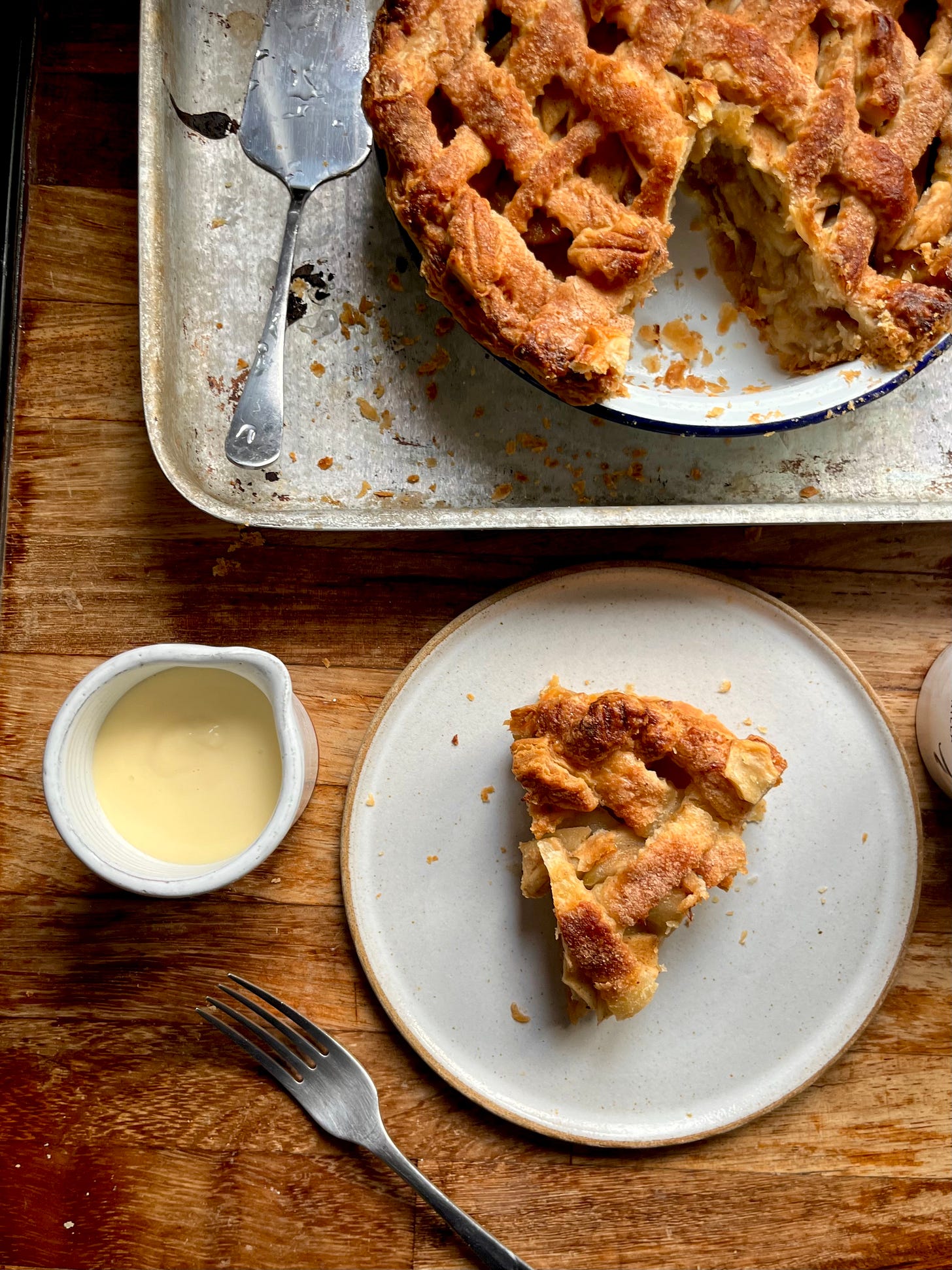
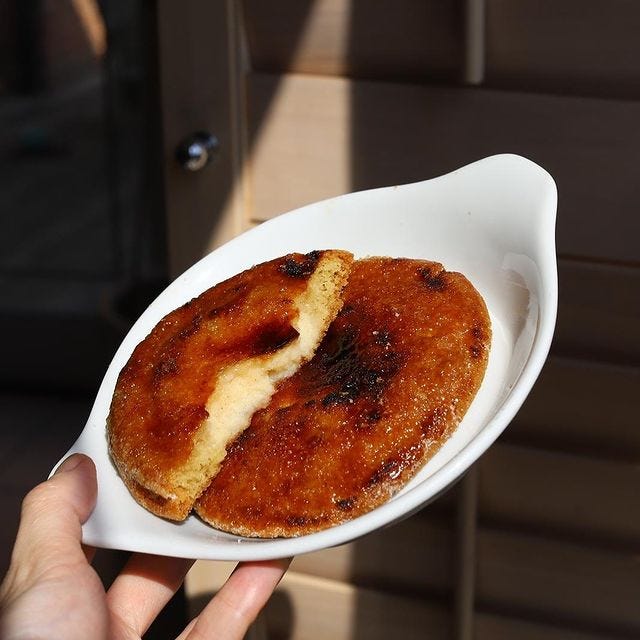
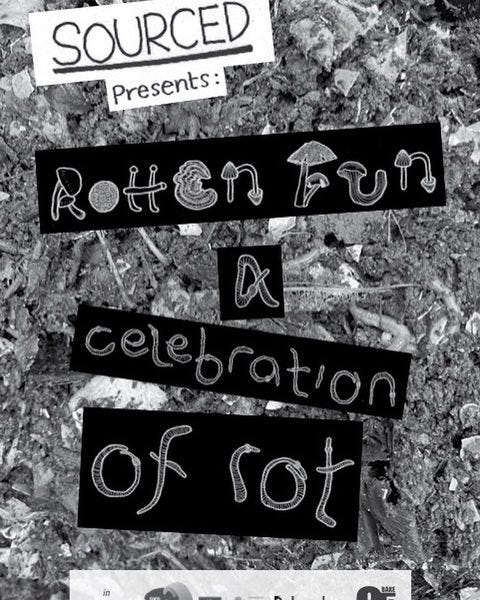
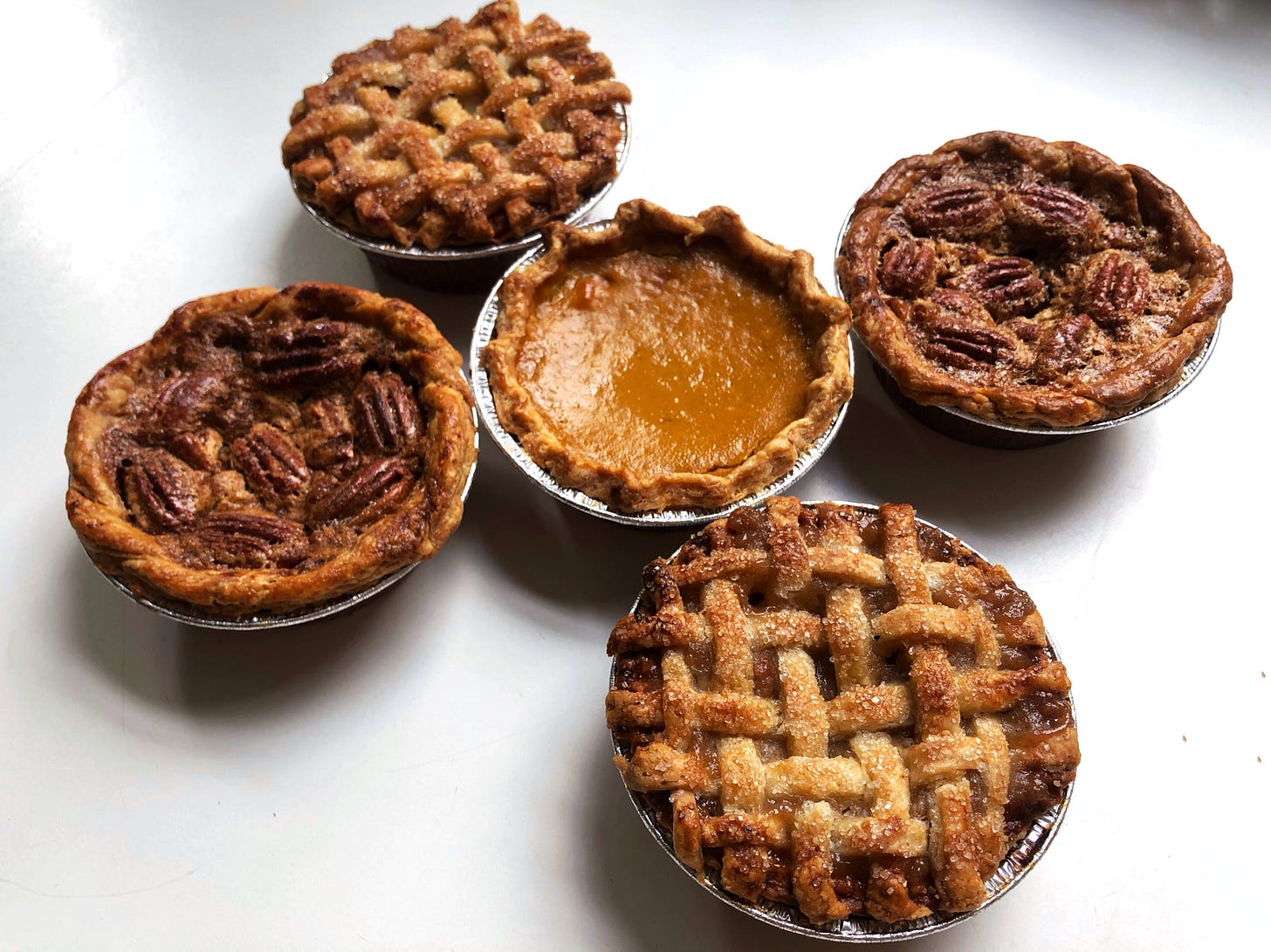
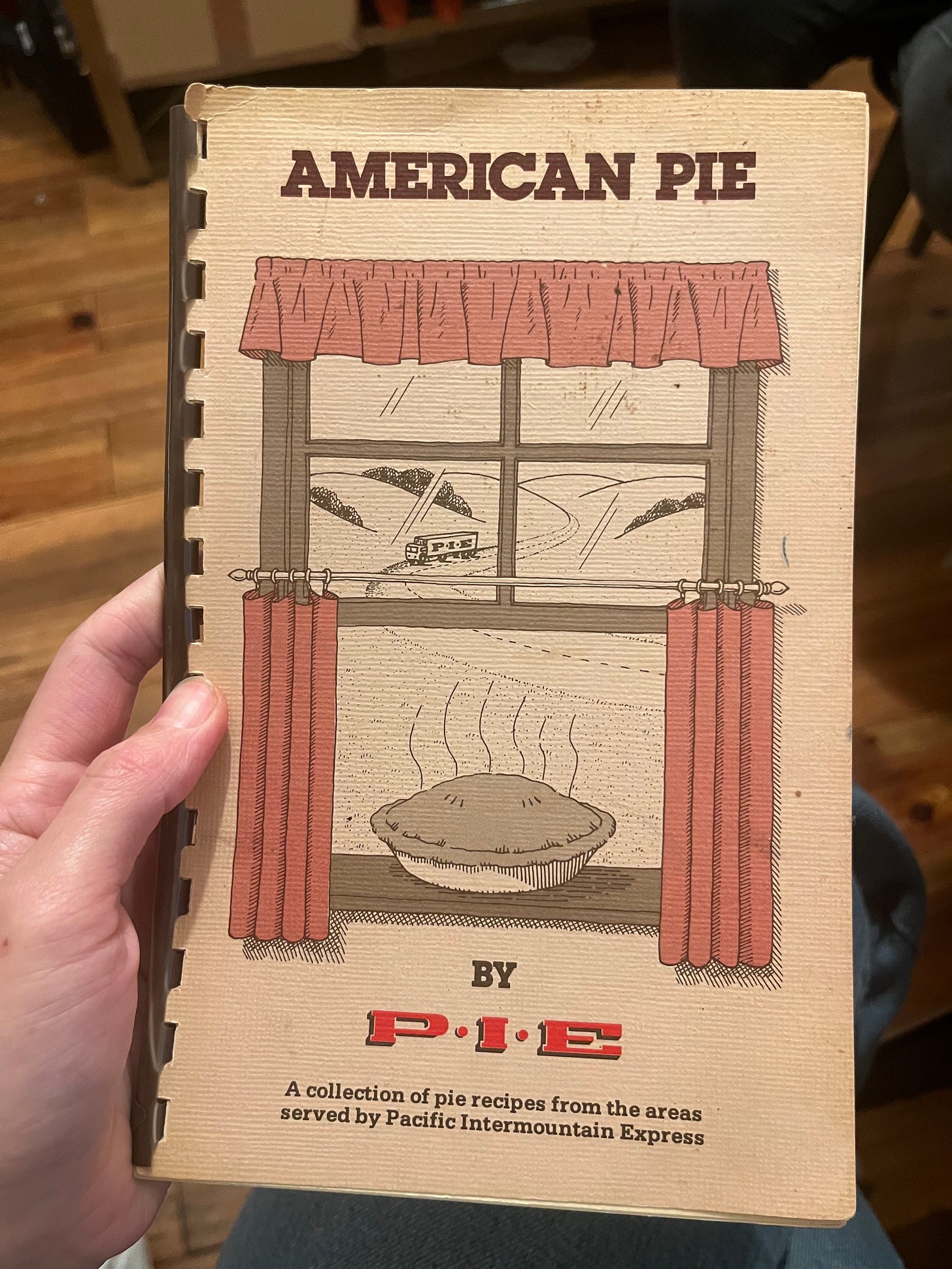
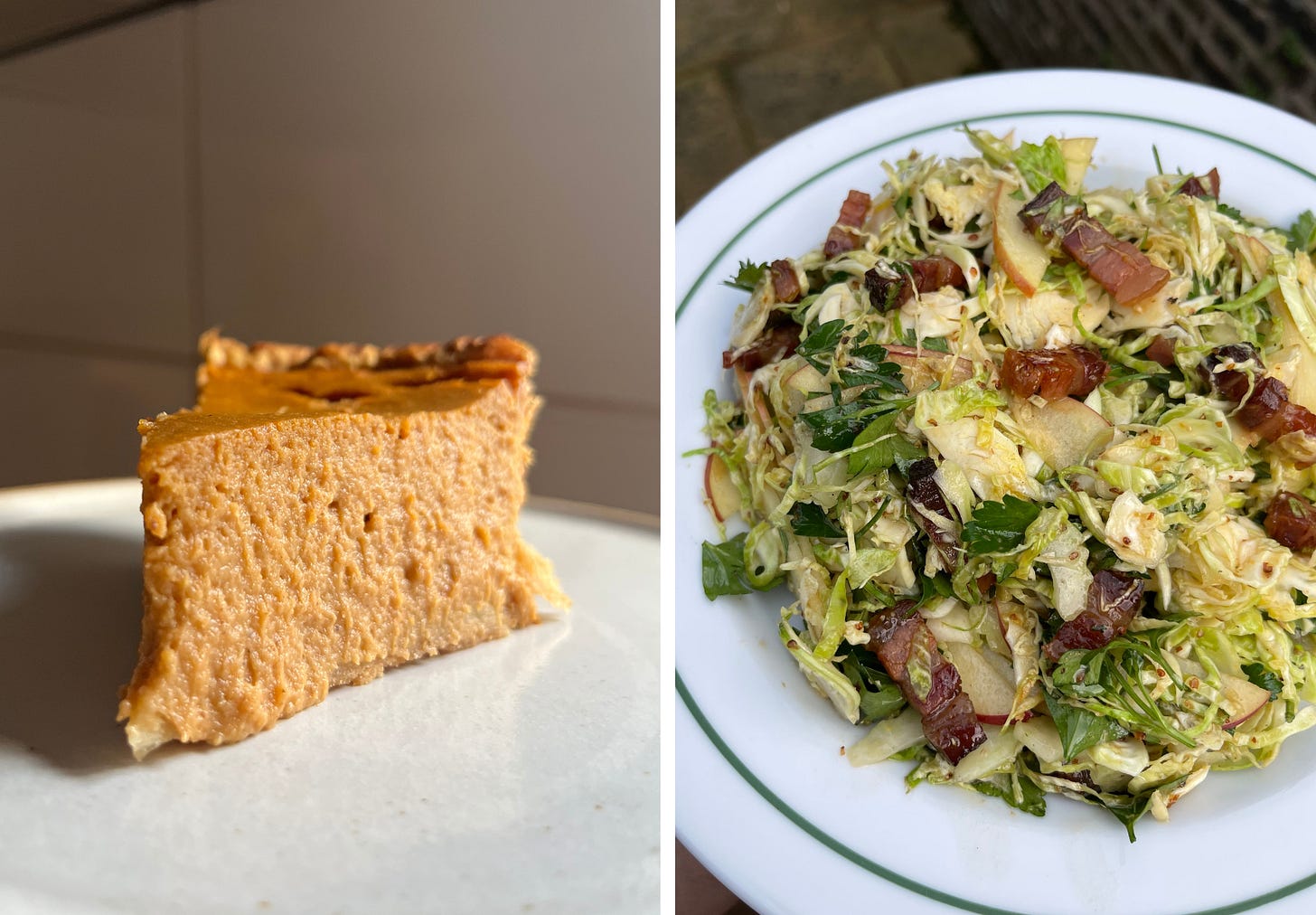
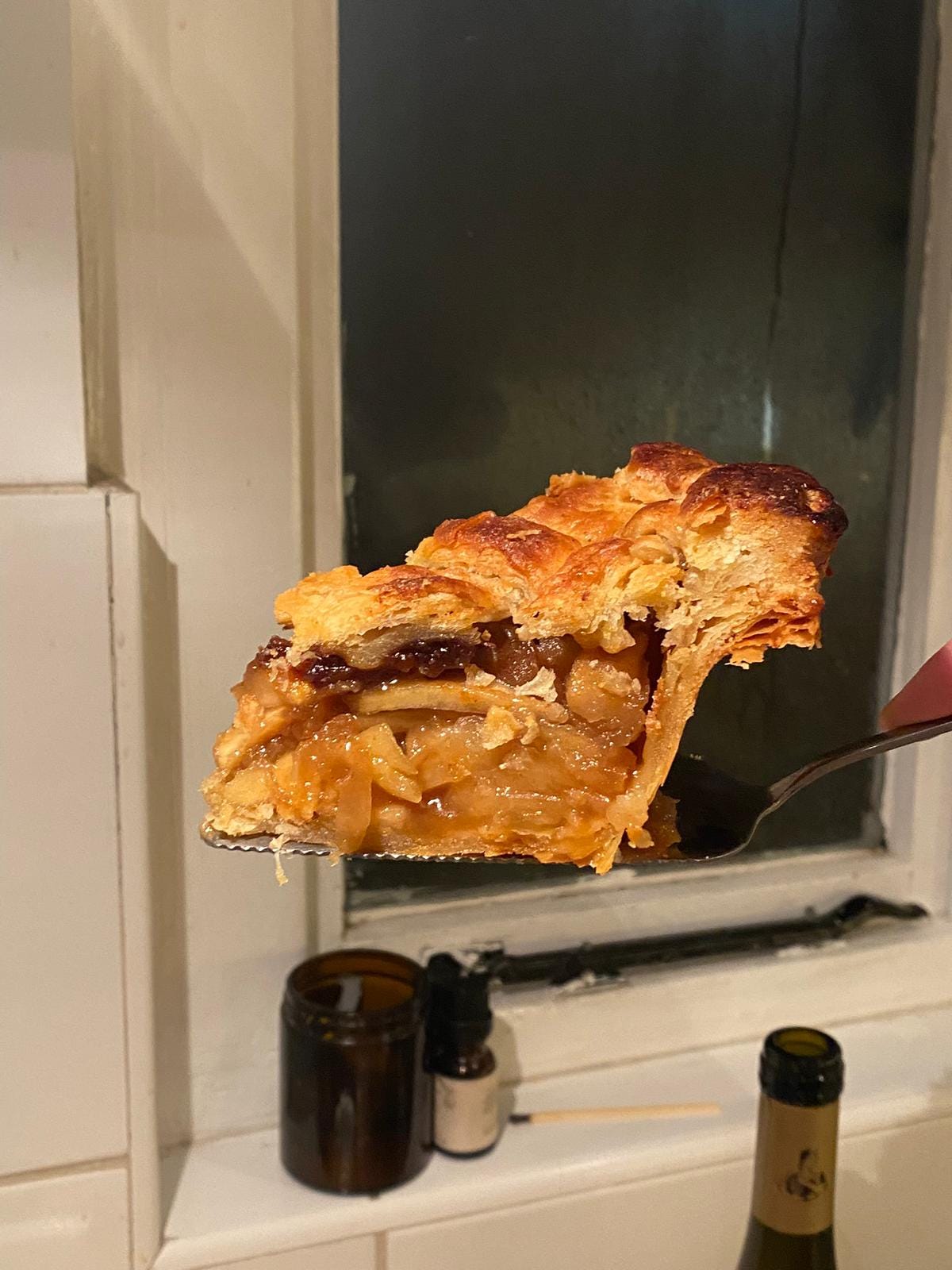
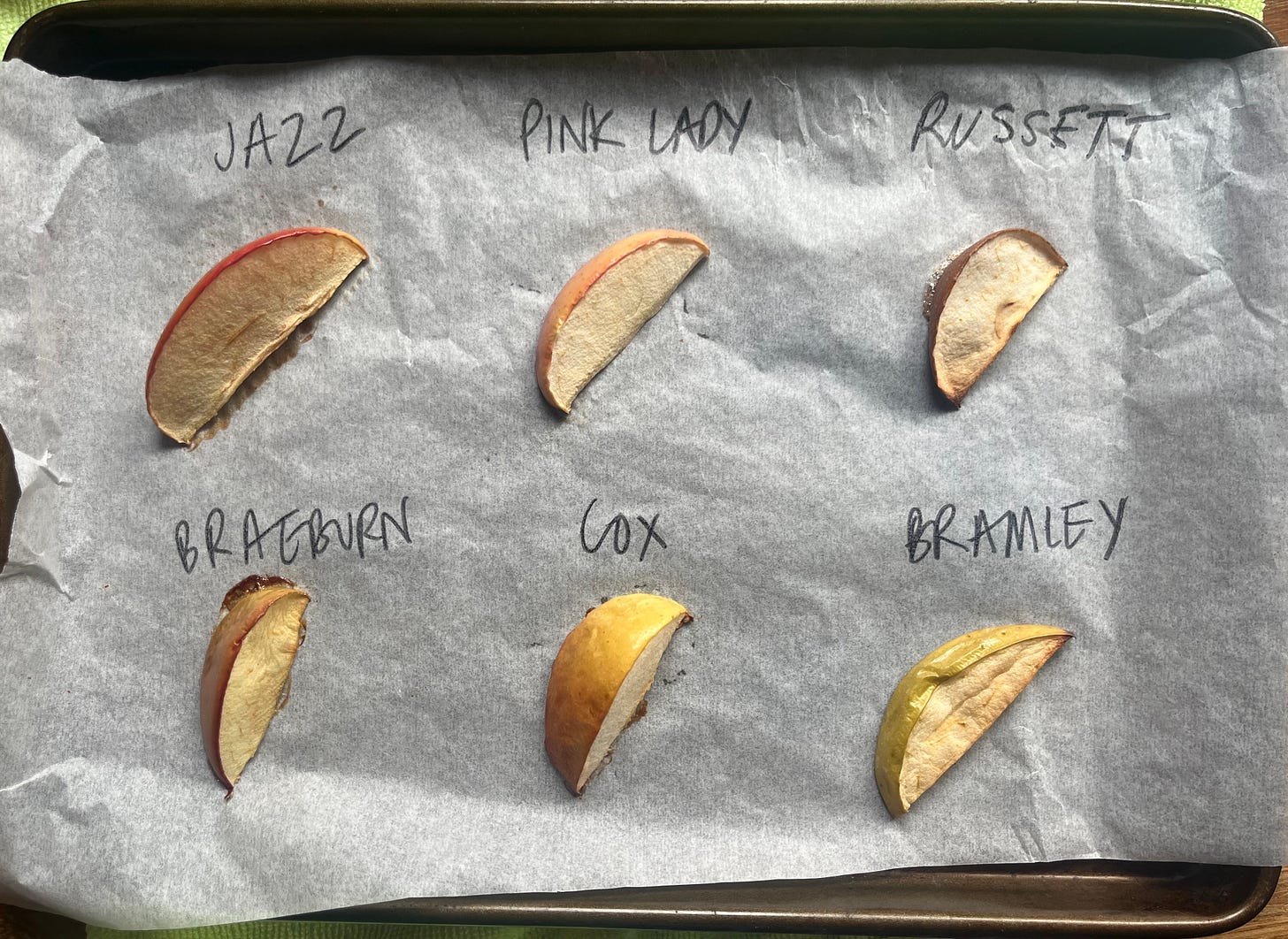
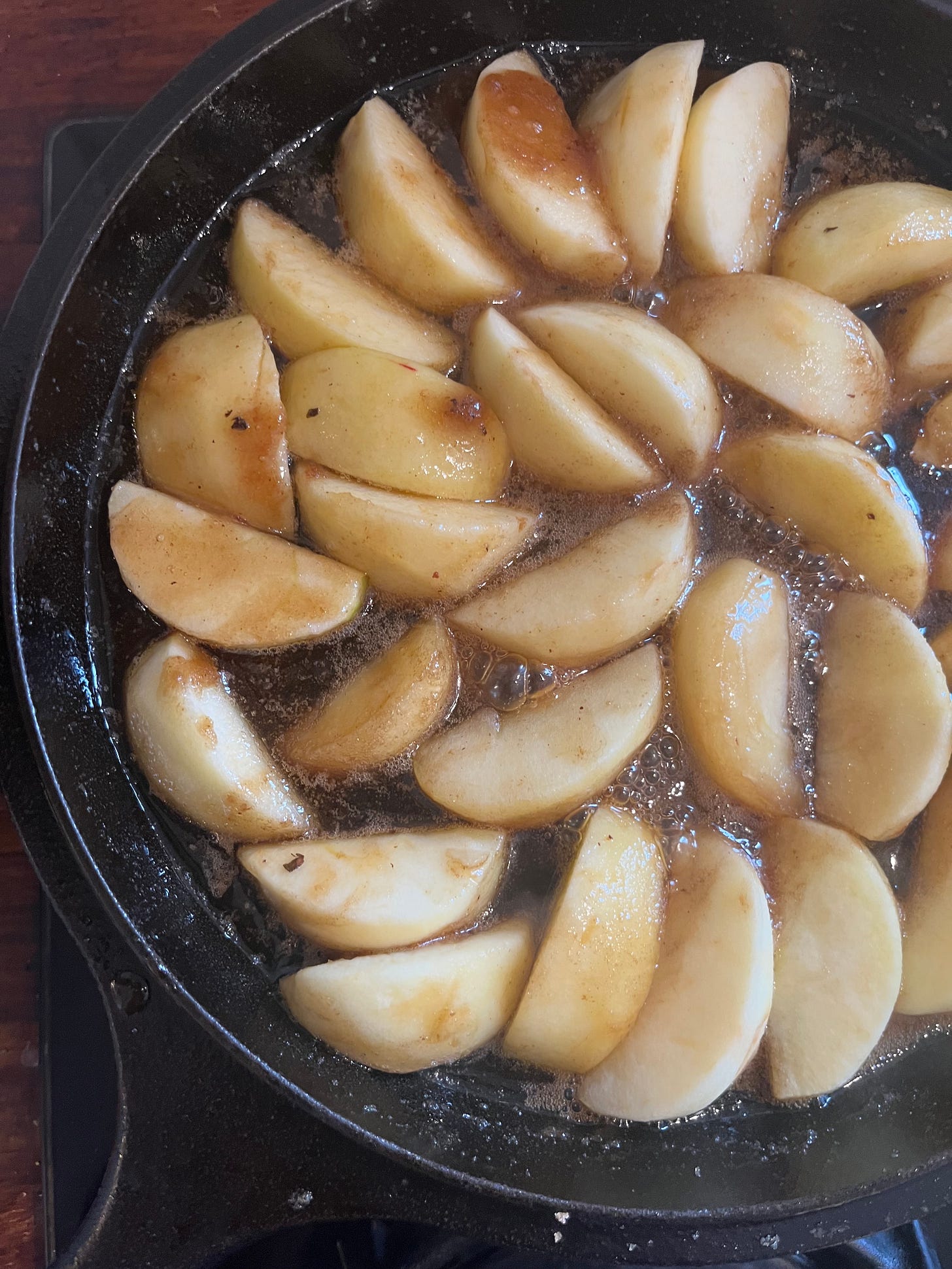
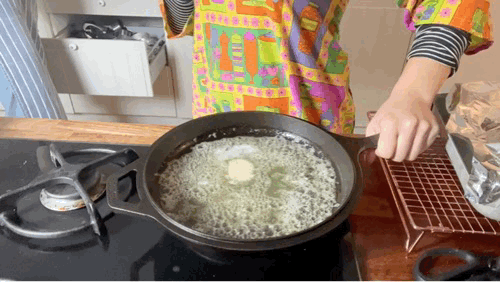
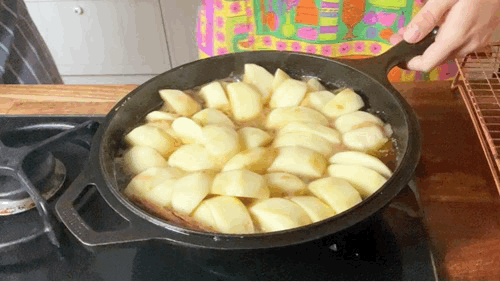
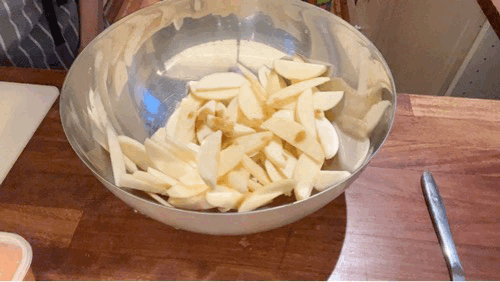
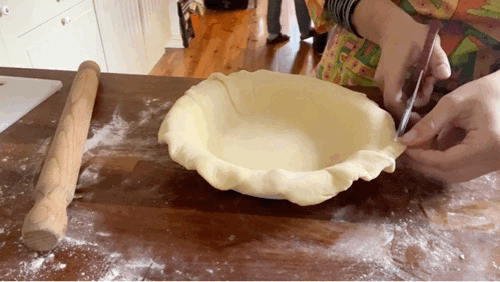
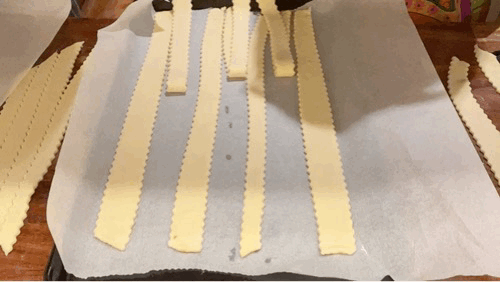
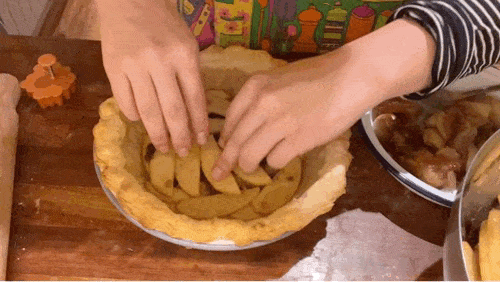
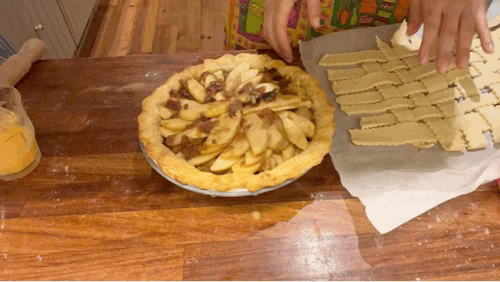
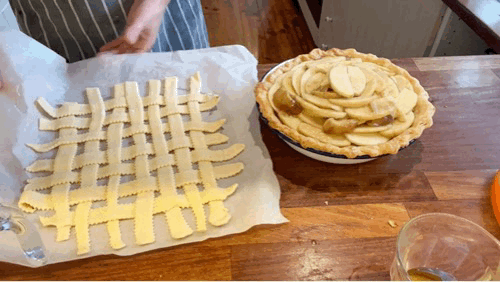
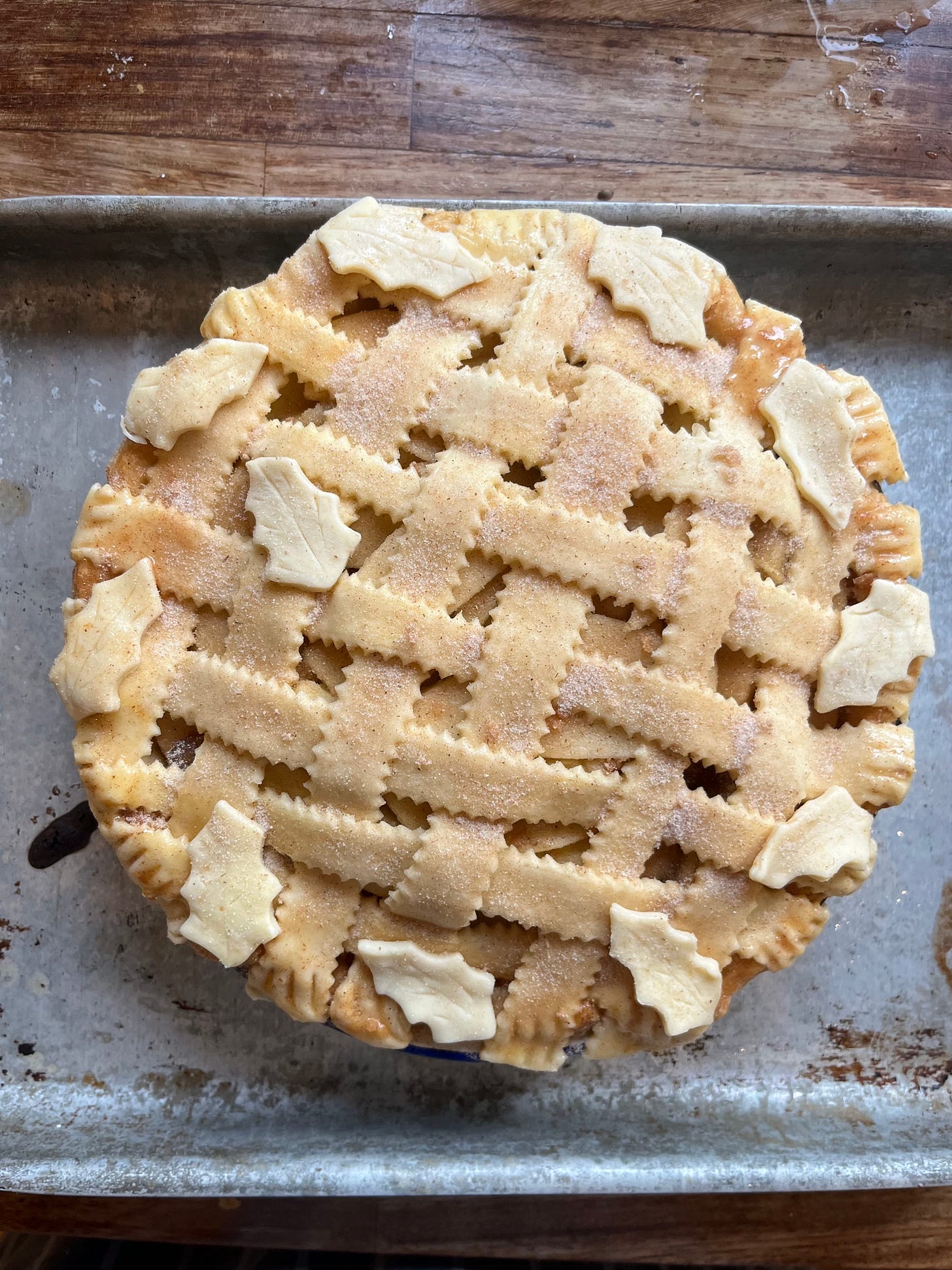
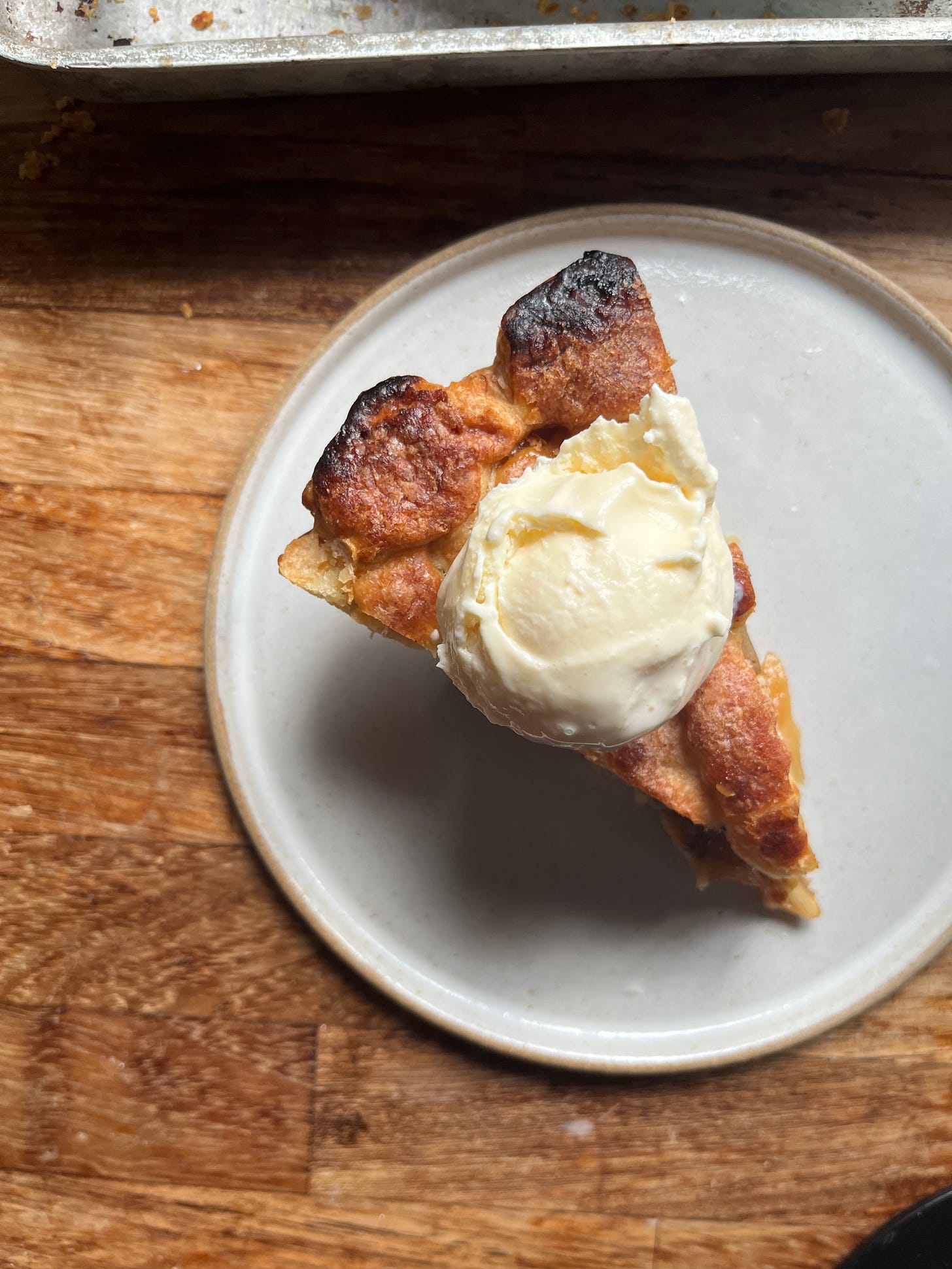
I’ve done thanksgiving since I first lived in the US around 25 years ago - I always make different dessert recipes every year to ring the changes. But there has to be cornbread stuffing too!
One of my UK-based American friends, from North Carolina, always does bourbon sweet potatoes. In my English opinion they’re better than marshmallow sweet potatoes, but not as good as sweet potatoes left to their own marvellous selves!